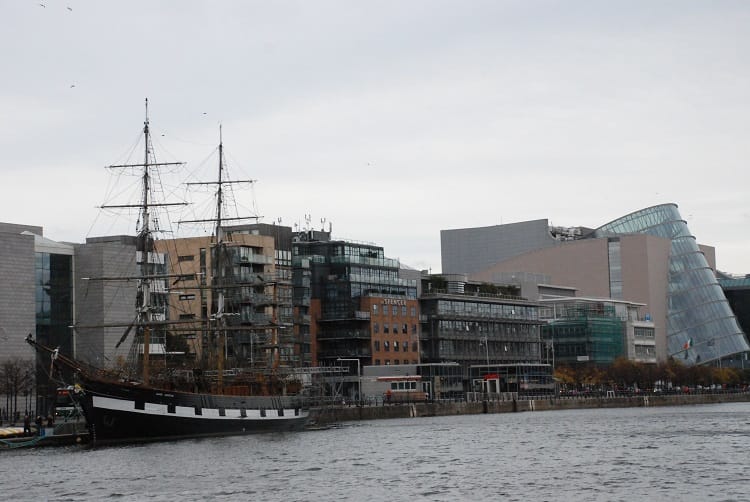Nobody caught illegally dumping yet by new north inner-city CCTV
But the scheme is a success, said a council official's report, as that shows the cameras are a deterrent.
That could mean historic ships, or ones with a cultural or community purpose, or tall ships. Or, just cool-looking ones.

“I’m all on for animating the Liffey and bringing the Liffey into the cityscape,” says independent Councillor Mannix Flynn. “But we’ve to get this right.”
Dublin City Council is currently polishing up a plan for how to make better use of some of the city’s waterways, which it is calling a “Water Animation Strategy”.
It hopes to bring “more activity and use of the water (around) the Docklands, the Liffey, the Canals and Docks”, according to a briefing document sent out last week.
The planned first steps? To issue leases of up to five years to vessels to moor in three areas along the Liffey: a pontoon to the east of Seán O’Casey Bridge, the area to the west of the Samuel Beckett Bridge, and an area at the east of the Talbot Memorial Bridge.
The council now wants to hear from “people, groups or companies who have viable and visually attractive proposals”.
Such a move should be welcomed, says Flynn. Because more often than not, “the river just seems to be used as some sort of dividing line”.
There are four types of vessels that the council says it’s looking to lease to.
Those include historic vessels with a connection to the city or Dublin Port, vessels with an arts or cultural or community purpose, tall ships and, lastly, and somewhat ambiguously, “visually interesting vessels”.
Large vessels won’t be considered. Vessels should be “no longer than 50m and no higher than 7m above the water line”, the call-out notes.
It’s welcome news, says Reg McCabe, spokesperson for Inland Waterways Association of Ireland (IWAI), which aims to enhance and promote Ireland’s waterways.
“I think it’s very positive,” he says. “It’s about looking at the water as part of the public realm, which is something we haven’t done in a number of years.”

“I’m young enough to remember the Guinness barges going up and down the Liffey,” says McCabe, who describes the Liffey as being akin to a public street.
“People are entitled to use it but the reason people don’t use it is because, psychologically, there’s a barrier,” he says.
Fine Gael Councillor Kieran Binchy agrees. “We should be using the city quays way more,” he says.
“We shy away from the Liffey. The boardwalk changed that slightly but we need to do more,” he says. “All the bridges that we have built are designed to allow boats in and out.”
A city beach should be considered as part of the changes too, says Binchy.
Something similar to the Paris Plages – a chain of artificial beaches created in summer along the River Seine. “It could mean more water sports and activities” along the Liffey, he says.
While the push to animate the Liffey is broadly welcomed, some point to concerns around some of the finer details – around pollution, and power, and just what boats Dubliners might soon see moored along the river.
Green Party Councillor Patrick Costello says that the council needs to put in a pollution-management plan. Ships need to be plugged into regular power supplies and have adequate access to waste disposal and sewerage, he says. “So that their presence doesn’t pollute the river.”
Along the river, at least one small trader has struggled in the past to get the electricity he says he needs to comfortably run his business.
“Equally if they are putting in power for these, it would be good to take the opportunity to provide power resources for other small traders in the area,” said Costello.
Otherwise it’s a solid plan, as he sees it. “It would be great to see life back on the river, particularly down towards the sea, which has become very sterile,” he said.
Independent Councillor Flynn points to the divisions in the Docklands “between those on a lower socio-economic scale and those on a higher socio-economic scale”, which makes him sceptical about the kinds of businesses that will set up at the three available locations.
Flynn says he worries that the council’s strategy could open the floodgates for hotel boats, boutique barges, and upper-crust floating bars. “But the Liffey needs to be brought back into the mindset of the people of Dublin,” he says.
As it stands, the somewhat rundown Jeanie Johnston is one of the few operational vessels along the river, says Flynn.
Says Binchy of Fine Gael: “What I don’t want to see is just a couple of high-end bars on boats. They won’t increase use of the area.”
“Temple Bar-On-Sea?” says IWAI’s McCabe. “No, there’d have to be a balance.”

“I’ve been trying to get the council to do this for years,” says Sam Field Corbett, who owns the MV Cill Airne bar and restaurant vessel on North Wall Quay and Escape Boats at Grand Canal Dock.
Corbett has applied to moor, eventually, the rusting Naomh Éanna which he bought for €1 in 2015 – along the Liffey. It’s currently docked at the far end of Grand Canal Dock. He says he aims to turn the boat into a hotel.
Corbett has also applied for a lease for a “tall ship” that he hopes to moor along the Liffey. The council should have a dedicated strip for “relevant, historic Irish boats”, he says.
Those hoping for a spot in one of the three areas chosen for this by the council have until 15 May to apply.
The IWAI’s McCabe worries that the rules and regulations attached to the invitation are “overly prescriptive”.
And, he says, “it’s certainly not giving people very much time to respond when you look at the amount of work that’s involved”.